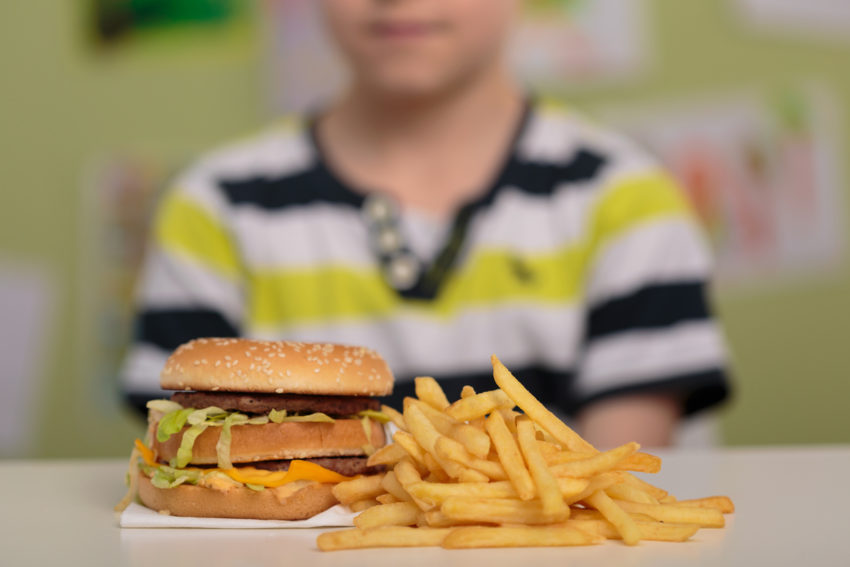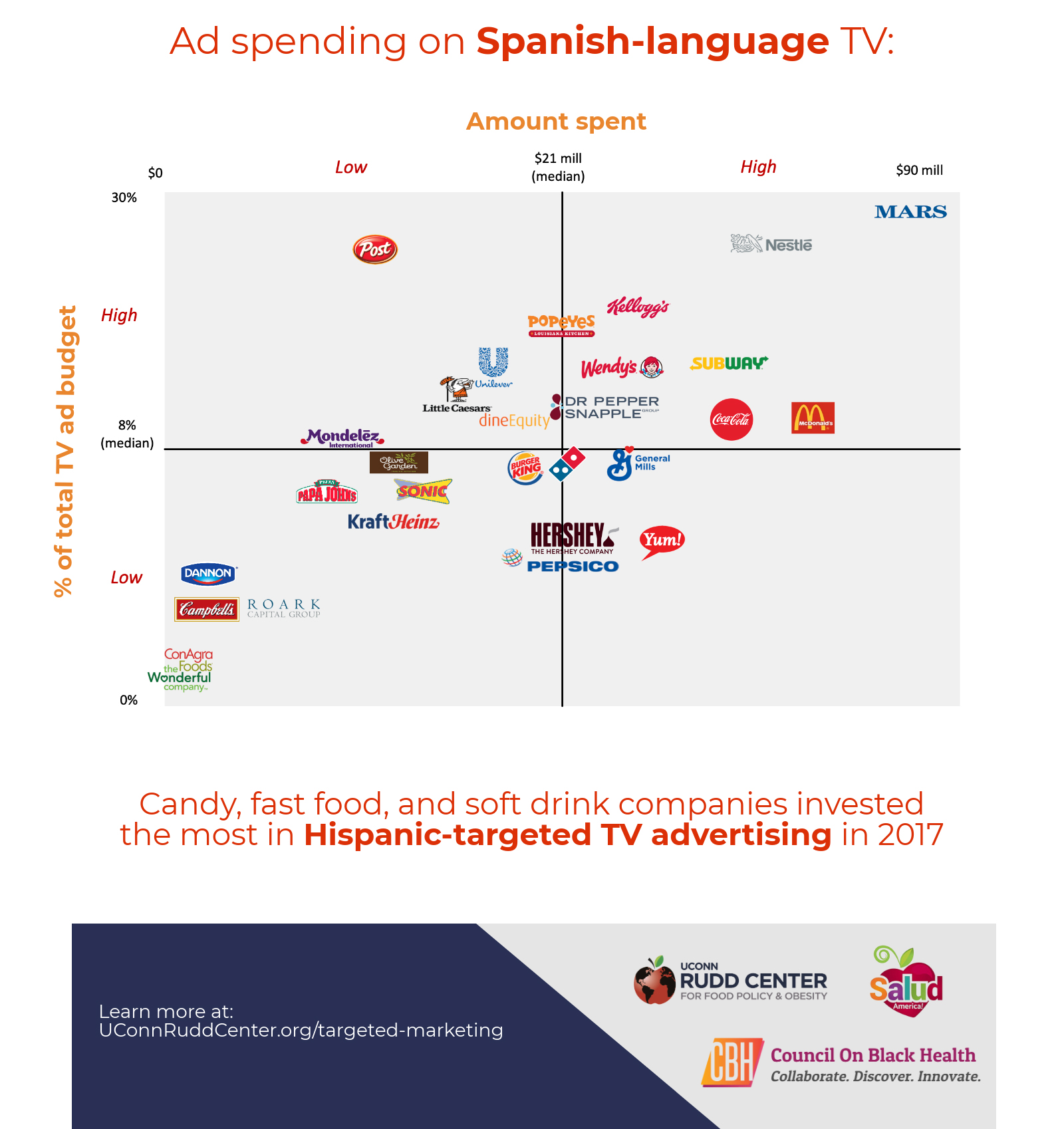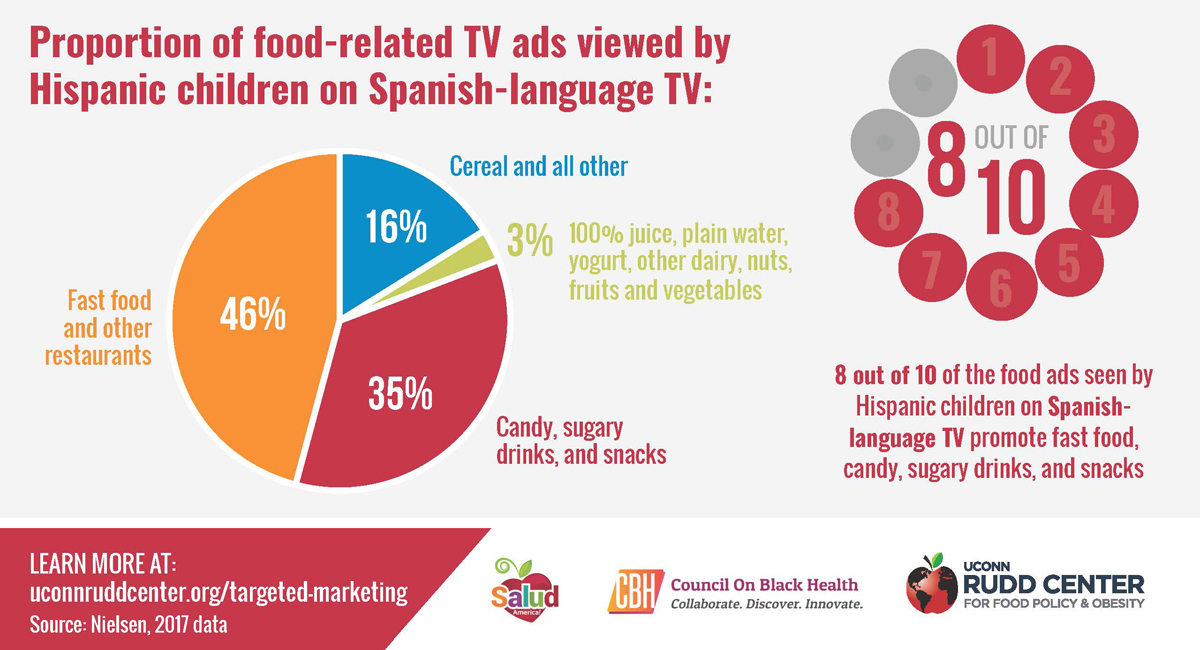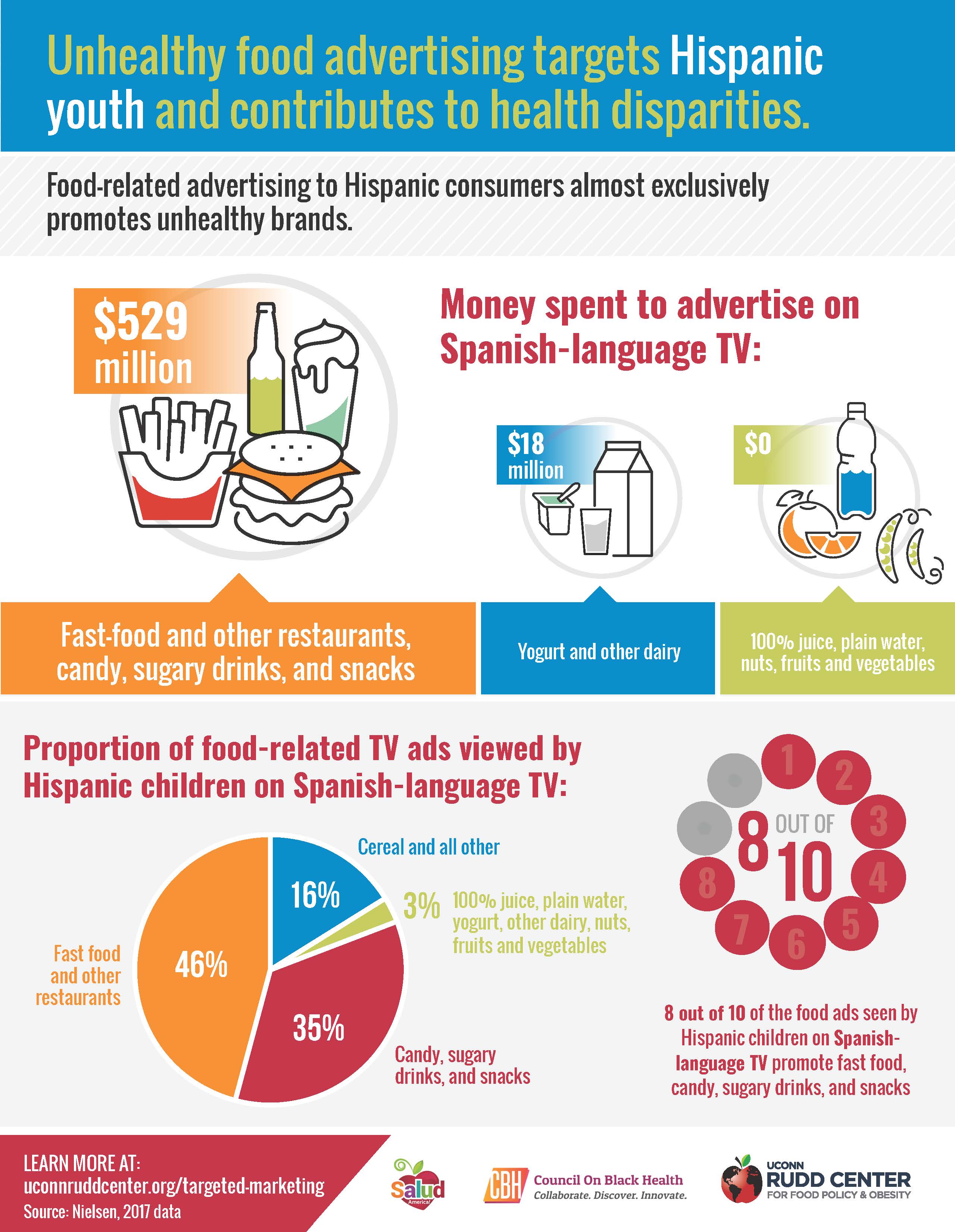
Share On Social!
Disparities in advertising for unhealthy food continue to target Latino and Black youth, according to a new report from Rudd Center for Food Policy & Obesity at the University of Connecticut, the Council on Black Health at Drexel University, and Salud America! at UT Health San Antonio.
Eight out of 10 food ads seen by Latino children on Spanish-language TV promote fast food, candy, sugary drinks, and snacks.
Unhealthy food marketing aimed at youth is a contributor to poor diets and related diseases, like obesity, diabetes, and heart disease. Targeting Latino and Black youth with unhealthy marketing contributes to disparities in health.
That’s why the UConn Rudd Center first explored food-related TV advertising in 2013.
Since then, the 10 companies with the most targeted advertising spending have launched or expanded corporate responsibility initiatives to promote nutrition and/or health and wellness, such as introducing new healthier products, reformulating existing products, and launching nutrition and healthy lifestyles education campaigns.
But did these companies make changes in their targeted advertising to also support health and wellness among Latino and Black consumers?

In January 2019, the Rudd Center analyzed targeted marketing of 32 companies and released a new report examining trends from 2013 to 2017 and targeted marketing by company, brand, and product category.
Junk Food Ads Rise from 2013 to 2017
Restaurants and packaged food and beverage companies spent $787 million on advertising on Spanish-language TV and $333 million on Black-targeted TV.
In 2017, Black children viewed 86% more and Black teens viewed 119% more food ads than their White peers viewed. This disparity in ads viewed is due to increased spending on Black-targeted TV advertising, differences in time spent watching TV, and differences in types of TV programming viewed.
Coca-Cola and Nestle more than doubled their Spanish-language advertising from 2013 to 2017, and nearly all companies increased their spending on Black-targeted TV from 2013 to 2017.
“This report shows just how much the food and beverage industry values Hispanic consumers when it comes to encouraging them to buy unhealthy products. But if the industry really values these consumers, companies will take responsibility for advertising that encourages poor diet and related diseases. They can start by eliminating the marketing of unhealthy products to Hispanic youth and families,” said Amelie G. Ramirez, DrPH, MPH, study author and director of Salud America! at the Institute for Health Promotion Research at UT Health San Antonio.
Targeting by Company
Food-related ads on Black-targeted and Spanish-language TV programming continue to almost exclusively promote unhealthy food and drinks.
Mars, Nestle, and Post Consumer Brands all spent more than one-quarter of their TV advertising budgets on Spanish-language TV.
Mars, McDonald’s, Nestle, Coca-Cola, and Subway each spent more than $45 million in Spanish-language advertising.
Dannon and Wonderful spent the least to advertise on Spanish-language TV and Black-targeted TV; however, these two companies offer primarily healthy products, including yogurt, fruit, and nut brands.
Top Targeted Brands

Two-thirds of the 236 highly advertised brands examined targeted Black and/or Latino consumers.
For example, 20 of 22 restaurant brands targeted Latino and/or Black consumers, with McDonald’s, Subway, Wendy’s, and Taco Bell ranking at the top in advertising on Spanish-language TV, and Taco Bell, Domino’s, Burger King, Wendy’s, and Arby’s ranking at the top in advertising on Black-targeted TV.
Coca-Cola Classic, M&Ms and Big G Cereals had the highest spending on Spanish-language TV and Lipton Iced Tea, Lay’s Potato Chips, Sprite, and Doritos had the highest spending on Black-targeted programming.
Big G Cereals, Pop Tarts, Extra gum, Special K cereal, and Lean Cuisine Marketplace Frozen Entrees invested 40% or more of their advertising budgets on Spanish-language TV.
Product Category
Restaurants (primarily fast food) represented 49% of spending on Spanish-language TV and 50% of Black-targeted TV advertising spending.
Although only representing 28% of all food-related advertising spending, candy (including gum and mints), sugary drinks, and savory and sweet snacks represented 33% of spending on Spanish-language TV and 36% on Black-targeted TV.
More than 70% of sugary drink and snack brands and 90% of restaurant and candy brands were significantly more likely to target Latino and Black consumers.
More than 80% of food-related ads viewed by Latino children and teens on Spanish-language TV were brands in these categories.

Latino children’s exposure to restaurant ads (again, primarily fast food) on Spanish-language TV increased by 8%, while restaurant ads viewed by Black children on all TV increased by 30%.
Approximately 20% of food-related TV ads viewed by Latino children and teens on Spanish-language TV were for candy.
In addition to seeing more ads for unhealthy foods, Latino and Black children and teens saw fewer ads for healthy foods.
Brands in the healthiest product categories (juice, water, nuts, and fruit) did not advertise at all on Spanish-language TV, and water, fruit, and nut brands did not target Black consumers.
Although targeted marketing is not problematic in and of itself, target advertising for products that are high in sugar, fat, sodium, and calories to Latino and Black consumers is a public health issue.
For example, Latino children and teens saw no ads for juice, water, nuts, or fruit on Spanish-language TV; however, these youth are disproportionately affected by diet-related diseases, like obesity, diabetes, and heart disease.

“It is unclear why companies with diverse portfolios of healthy and unhealthy brands in multiple categories almost exclusively target Latino and Black consumers with ads for their unhealthy brands,” the authors state.
Particularly when these companies publicize corporate responsibility initiatives to promote nutrition and/or health and wellness, many of which promote sponsorships and scholarships aimed at communities of color.
Recommendations
Although a growing number of obesity prevention policies and actions have been implemented to counteract unhealthy marketing, these measures do not address unhealthy marketing directly targeted to Latino and Black youth.
The one entity that exists to reduce unhealthy advertising to children under age 12 is the Children’s Food and Beverage Advertising Initiative (CFBAI). CFBAI is a voluntary food industry self-regulatory program through which participating companies pledge to only advertise healthier choices in child-directed media.
However, many of the companies examined in this report participate in CFBAI, which suggests that voluntary regulation is failing to protect youths of color from youth-targeted brands.
“We continue to call on food manufacturers to market healthy products to Black and Latino consumers and for fast-food, candy, sugary drink, and unhealthy snack food brands to stop disproportionately targeting their advertising in Spanish-language and Black-targeted media,” the authors state.
This report highlights the need for extensive action to reduce targeted marketing to Latino and Black youth:
- Companies that participate in the CFBAI must address loopholes that allow them to continue to target marketing of unhealthy products to children, including raising the age of children covered by pledges to at least 14 years old and implementing other recommendations from public health experts.
- The CFBAI should specifically limit targeted marketing of unhealthy products directly to Black and Latino children.
- Sugary drink, candy, and nutritionally poor snack food brands and fast-food restaurants – food and beverage categories that have been shown to directly contribute to obesity and other diet-related diseases among youth – should stop targeting advertising to all young people under 18, including multicultural youth.
- Corporate responsibility initiatives to promote nutrition and/or health and wellness should also address targeted marketing of unhealthy products to communities of colors and commit to discontinuing practices that contribute to diet-related diseases in these communities.
- Media companies that own programming with large audiences of Latino and/or Black youth should take action to improve the nutritional quality of foods advertised during targeted programming.
- Media companies should establish nutrition standards for products advertised to youth on their Black- and Latino-targeted programming that align with the Dietary Guidelines for Americans.
- Public health advocacy campaigns should focus on improving marketing practices of companies that disproportionately target Latino and Black youth.
- Public health advocacy campaigns should explore opportunities to engage youth of color in campaigns to address targeted food marketing as a social justice issue.
- Latino and Black consumers could demand that companies improve the quality of foods marketed to their children and in their communities.
As examples of actions around food and drink marketing, sugary drink price increases continues to gain momentum, alongside other bold strategies. London plans to ban ads for unhealthy food on public transportation in February 2019, as a way to reduce rising obesity rates.
The Berkeley Media Studies Group also has a helpful guide on how to frame junk food marketing as a health equity issue.
Download the new Rudd Center report to learn more.
By The Numbers
1
Supermarket
for every Latino neighborhood, compared to 3 for every non-Latino neighborhood



